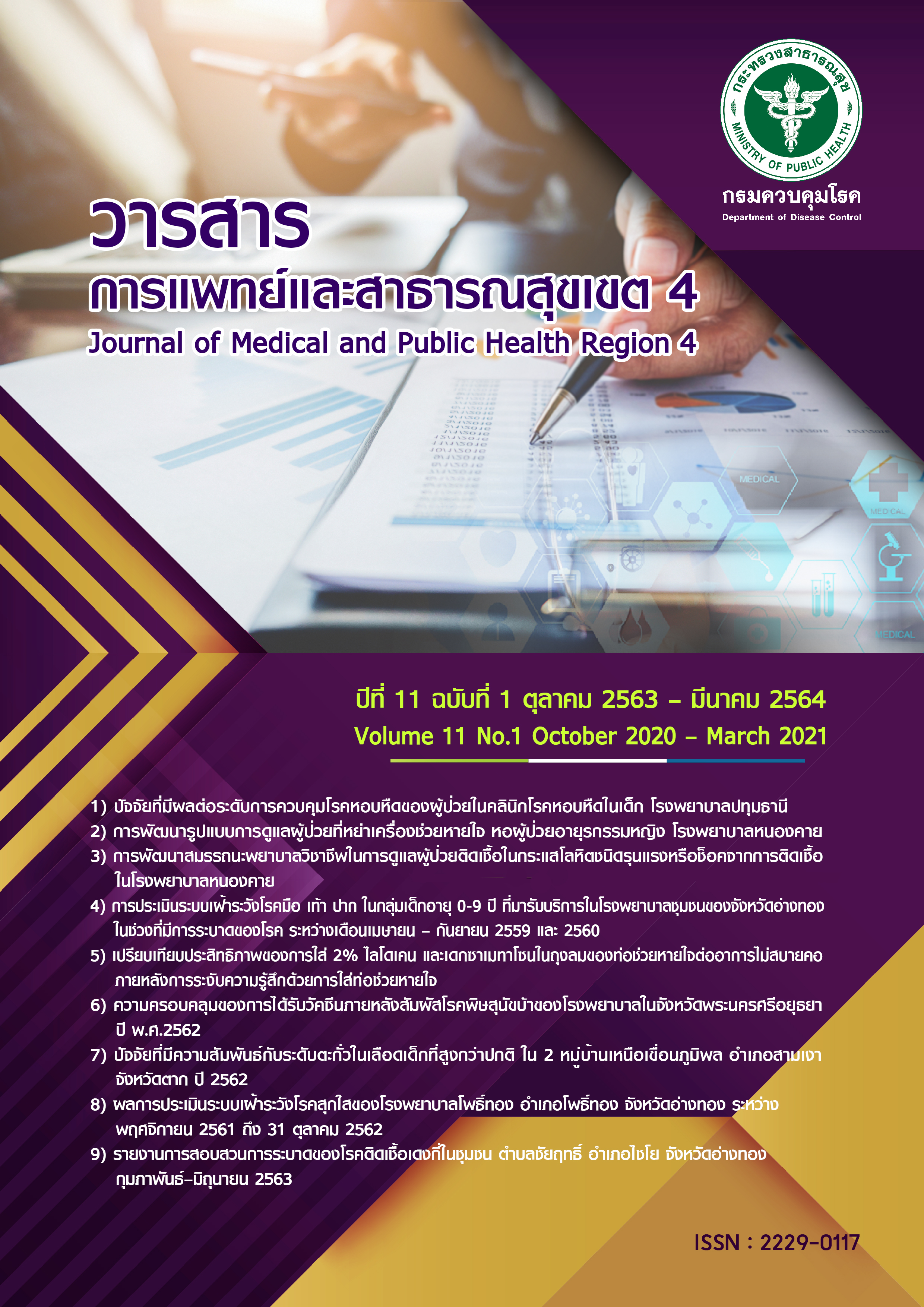เปรียบเทียบประสิทธิภาพของการใส่ 2% ไลโดเคน และ เดกซาเมทาโซนในถุงลมของท่อช่วยหายใจต่ออาการไม่สบายคอภายหลังการระงับความรู้สึกด้วยการใส่ท่อช่วยหายใจ
Main Article Content
บทคัดย่อ
งานวิจัยนี้ทำขึ้นเพื่อเปรียบเทียบประสิทธิภาพ การลดอาการไม่สบายบริเวณกล่องเสียงและหลอดลม และความพึงพอใจ ระหว่างการใส่ไลโดเคน และ เดกซาเมทาโซน ในถุงลมของท่อช่วยหายใจของผู้ป่วยที่มาเข้ารับการระงับความรู้สึกแบบทั้งตัว เป็นการศึกษาแบบ prospective Randomized Controlled Trial ในผู้ป่วย จำนวน 93 ราย โดยจะได้รับยาแตกต่างกันไปด้วยวิธีสุ่ม แบ่งเป็น 3 กลุ่ม ดังนี้ กลุ่ม A ได้รับยา 2%ไลโดเคน กลุ่ม B ได้รับยาเดกซาเมทาโซน และกลุ่ม C ได้รับสารน้ำเกลือ ประเมินระดับความรุนแรงของอาการเจ็บคอ เสียงแหบ และกลืนลำบาก โดยใช้ตั้งแต่ระดับ 0 ถึง 3 วัดที่ 1 ชั่วโมง และ 24 ชั่วโมงภายหลังการระงับความรู้สึก และสอบถามระดับความพึงพอใจของผู้เข้ารับบริการแบ่งเป็นระดับ 1 ถึง 5 โดยผลการศึกษาพบว่าที่เวลา 1 ชั่วโมง ไลโดเคน ลดอาการเจ็บคอได้ดีกว่า เดกซาเมทาโซนและสารน้ำเกลือ (P=0.001) เมื่อเปรียบเทียบที่เวลา 24 ชั่วโมง ไลโดเคนและเดกซาเมทาโซน มีประสิทธิภาพดีกว่าสารน้ำเกลือในการลดเจ็บคอ (p<0.001, p=0.006 ตามลำดับ) และในกลุ่ม ไลโดเคน พบอาการกลืนลำบากและเสียงแหบน้อยกว่ากลุ่ม เดกซาเมทาโซนและสารน้ำเกลือ อย่างมีนัยสำคัญทางสถิติ (p=0.001, p=0.027, p=0.002, p=0.001 ตามลำดับ) เปรียบเทียบความพึงพอใจภายหลังการใส่ท่อช่วยหายใจ พบว่าไม่มีความแตกต่างกันทางสถิติ (P=0.129) สรุปผลการศึกษาพบว่า การใส่ ไลโดเคน ในถุงลมของท่อช่วยหายใจสามารถลดอาการเจ็บคอได้ดีกว่า เดกซาเมทาโซน ที่ระยะเวลา 1 ชั่วโมง และที่เวลา 24 ชั่วโมง ไลโดเคน ลดอาการเสียงแหบและกลืนลำบากได้ดีกว่า เดกซาเมทาโซน แต่อาการเจ็บคอนั้นไม่แตกต่างกัน
Article Details
เอกสารอ้างอิง
2. Biro P, Seifert B, Pasch T. Complaints of sore throat after tracheal intubation: a prospective evaluation. Eur J Anaesthesiol 2005; 22: 307-11.
3. Higgins PP, Chung F, Mezei G. Postoperative sore throat after ambulatory surgery. Br J Anaesth 2002; 88: 582-4.
4. Maruyama K, Sakai H, Miyazawa H, Toda N, Iinuma Y, Mochizuki N, et al. Sore throat and hoarseness after total intravenous anaesthesia.Br J Anaesth 2004; 92: 541-3.
5. Ahmed A, Abbasi S, Ghafoor HB, Ishaq M. Postoperative sore throat after elective surgical procedures. J Ayub Med Coll Abbottabad 2007; 19: 12-4.
6. Hisham AN, Roshilla H, Amri N, Aina EN. Postthyroidectomy sore throat following endotracheal intubation. ANZ J Surg 2001; 71: 669-71.
7.Singh M, Malhotra N, Malhotra S. Tracheal morbidity following tracheal intubation: Comparison of air, saline and lignocaine used for inflating cuff. J Anaesthesiol Clin Pharmacol. 2007;23(2):163–7.
8. Chen KT, Tzeng JI, Lu CL, Liu KS, Chen YW, Hsu CS, et al. Risk factors associated with postoperative sore throat after tracheal intubation: an evaluation in the postanesthetic recovery room. Acta Anaesthesiol Taiwan 2004; 42: 3-8.
9. Stanley TH, Kawamura R, Graves C. Effects of nitrous oxide on volume and pressure of endotracheal tube cuffs. Anesthesiology 1974; 11: 256-61.
10. Bahk JH, Lim YJ. Use of intracuff lidocaine during general anesthesia. Anesth Analg. 2001;92(4):1075.
11. Bennett MH, Isert PR, cumming RG. Postoperative sore throat and hoarseness following tracheal intubation using air or saline to inflate the cuff-a randomized controlled trial. Anaesth Intensive Care 2000; 28:408-13.
12. Tanaka Y, Nakayama T, Nishimori M, Sato Y, Furuya H. Lidocaine for preventing postoperative sore throat. Cochrane Database Syst Rev. 2009;(3):CD004081.
13. Thomas S, Beevi S. Dexamethasone reduces the severity of postoperative sore throat. Can J Anaesth. 2007;54(11):897–901.
14.Brandt L, Pokar H. The rediffusion system. Limitation of nitrous oxide increases the cuff pressure of endotracheal tube. Anaesthesist 1983; 32:459-64.
15. Nguyen TH, Saidi N, Lieutaud T, Bensaid S, Menival V, Duvaldestin P. Nitrous oxide increases endotracheal cuff pressure and the incidence of tracheal lesions in anesthetized patients. Anesth Analg 1999; 89:187-90.
16.Fagan C, Frizelle HP, Laffey J, Hannon V , Carey M. The effects of intracuff lidocaine on endotrachealtube-induced emergence phenomena after general anesthesia. Anesth Analg. 2000;91(1):201–5.


